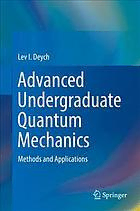
Advanced undergraduate quantum mechanics PDF
Preview Advanced undergraduate quantum mechanics
Lev I. Deych Advanced Undergraduate Quantum Mechanics Methods and Applications Advanced Undergraduate Quantum Mechanics Lev I. Deych Advanced Undergraduate Quantum Mechanics Methods and Applications 123 LevI.Deych PhysicsDepartment QueensCollegeandtheGraduateCenter CityUniversityofNewYork NewYork,NY,USA ISBN978-3-319-71549-0 ISBN978-3-319-71550-6 (eBook) https://doi.org/10.1007/978-3-319-71550-6 LibraryofCongressControlNumber:2017961762 ©SpringerInternationalPublishingAG,partofSpringerNature2018 Thisworkissubjecttocopyright.AllrightsarereservedbythePublisher,whetherthewholeorpartof thematerialisconcerned,specificallytherightsoftranslation,reprinting,reuseofillustrations,recitation, broadcasting,reproductiononmicrofilmsorinanyotherphysicalway,andtransmissionorinformation storageandretrieval,electronicadaptation,computersoftware,orbysimilarordissimilarmethodology nowknownorhereafterdeveloped. Theuseofgeneraldescriptivenames,registerednames,trademarks,servicemarks,etc.inthispublication doesnotimply,evenintheabsenceofaspecificstatement,thatsuchnamesareexemptfromtherelevant protectivelawsandregulationsandthereforefreeforgeneraluse. Thepublisher,theauthorsandtheeditorsaresafetoassumethattheadviceandinformationinthisbook arebelievedtobetrueandaccurateatthedateofpublication.Neitherthepublishernortheauthorsor theeditorsgiveawarranty,expressorimplied,withrespecttothematerialcontainedhereinorforany errorsoromissionsthatmayhavebeenmade.Thepublisherremainsneutralwithregardtojurisdictional claimsinpublishedmapsandinstitutionalaffiliations. Printedonacid-freepaper ThisSpringerimprintispublishedbytheregisteredcompanySpringerInternationalPublishingAGpart ofSpringerNature. Theregisteredcompanyaddressis:Gewerbestrasse11,6330Cham,Switzerland ToYelena,Daniil,Sergei,andmydogXena Preface Themarketforundergraduatetextbooksonquantummechanicsisoversaturatedas one can literally choose from tens, if not hundreds, of different titles, with several ofthembeingacceptedasastandard.Writingyetanothertextbookonthissubject mightappearasarecklessandtime-consumingadventure,andwhoevergotengaged in it can be rightfully suspected in arrogance and self-aggrandizement. Be that as it may, after 15 years of teaching an undergraduate quantum mechanics course at Queens College of the City University of New York, I finally came to realization that neither I nor my students are particularly happy with the existing standards. It also occurred to me that my approaches to teaching various topics in quantum mechanics,alongwiththelecturenotesIhaveaccumulatedovertheseyears,could form the foundation of atextbook that would be different from those Isaw on the market.Inmanycases,studentstreattheirphysicstextbooksasareferencesource for formulas and postulates—used to solve problems rather than as actual reading material.I,ontheotherhand,dreamedaboutwritingabookthatwouldactuallybe read;andinordertoachievethat,Ihavedevotedasignificantamountoftimetothe explanation of the most minute technical details of various technical derivations. The level of technical detail in the book would ideally allow students to use it without the need for a lecturer’s explanations, allowing professors to use precious lecturetimeonsomethingmoreproductiveandfun.Butquantummechanicsisnot just about derivations of formulas (though these might be fun, of course, for the mathematicallyinclined).Thephysicalcontentofthederivedresultsisimmensely more important and interesting, if you ask me. Thus, I have included in the text extensive qualitative discussions of the physical significance of derived formulas andequations.Finally,tomakereadingevenmoreenjoyable,Itriedtopreservethe informal, colloquial style of my lectures, addressing readers directly and avoiding thedry,impersonalmannerfoundintoomanyformalscientifictexts. Mostphysicstextbookspresentideasandconceptswithoutmorethanapassing mentionofthepeoplewhodiscoveredthem.Suchanapproachaimstoemphasize the objectivity of the laws and principles that physics deals with. The essence of theselawsdoesnotdependonthepersonaltraitsandideologiesoftheirdiscoverers, whichisnotalwaysthecaseinhumanities.WhileIagreethatsuchacold,formal ix x Preface approachisjustifiedbytheobjectivenatureofthelawsofphysics,Iamstillnotsure thatitisthebestwaytopresentthematerialtostudents.Thisapproachdehumanizes physics,preventingpeoplefromrelatingtoitonapersonallevelandseeingphysics as part of the general human experience. In this book, I tried to break out of this tradition and introduced some personal details about the lives of those scientists whowereresponsiblefordevelopingquantumtheoryandchangingourviewsofthe universealongtheway.Iwouldlikethereaderstoseethatthecomplextechnicaland philosophicalideasinquantummechanicsweregeneratedbymortalhumanbeings withstrengthsandweaknesses—thattheyexperiencedstrugglesandmademistakes forwhichtheyhadtobearfullresponsibility.Obviously,itwouldbeimpossibleto talkaboutallthesegreat(andsometimesnotsogreat)men1indetail.Butwhenever possible,Ihavetriedtoprovidebitsandpiecesaboutthepersonallivesofscientists whosenamesappearinthetext. Anyone writing a textbook on such an immense subject as quantum mechanics alwaysstruggleswiththequestionofwhichtopicstoincludeandwhichtoleaveout. There are, of course, some standard concepts that cannot be avoided, but beyond those,thechoiceisalwaysafunctionoftheauthor’spersonalpredilections.These predilections led me to include some topics that are not usually covered in under- graduate textbooks, such as the Heisenberg equations, the transfer-matrix method forone-dimensionalproblems,opticaltransitionsinsemiconductors,Landaulevels, andtheHallconductivity.Atthesametime,IleftoutsuchpopulartopicsasWKB andvariational methods. Thetotalcontents ofthebookwerechosen tosatisfythe needs of a two-semester course for students who have already been exposed to some quantum ideas in a modern physics course or its equivalent. At the same time, the book can also be used for a one-semester course. While each instructor decidingtoadoptthisbookcanchoosewhatevermaterialtheypreferfortheirone- semestercourse,mysuggestionwouldbetoincludeChaps.1through9,aswellas Chaps.11and15,whichcanbetaughtalmostindependentlyofotherchaptersofthe book.(Whiletherearesomecross-referencesbetweentheseandotherchapters,they shouldn’timpedethestudent’sorinstructor’sabilitytogetthroughthearguments.) Finally, I would like to emphasize that the problems offered for solution by the studentsareanintegralpartofthetextandmustbetreatedassuch. Quantummechanicsisoneoftheultimatetriumphsofthehumanmind.Ienjoyed writing this book, trying to convey the awesomeness of quantum ideas and of the peoplewhocontributedtotheirdevelopment,andIhopethatyouwillenjoyreading 1Needlesstosay,atthetimeofbirthofquantumphysics,mostofthescientistswere,indeed,men. Evenmoreremarkableareachievementsofafewwomenwholefttheirmarksonthetwentieth- century physics. Nobel Prize winners Marie and Irene Curie have since become household names,butotherfemalescientistssuchasGermanmathematicianEmmyNoetherandAustrian- Swedish experimental physicist Lise Meitner also deserve to be remembered. Unfortunately, the contributions of Noether, who uncovered the intimate relationship between symmetries and conservationlaws,andMeitner,whotogetherwithOttoHahndiscoveredthefusionofuranium, aretooadvancedforanintroductoryquantummechanicsbook,preventingmefromtalkingabout thesescientistsinmoredetail. Preface xi it.Whilephysicsstudents,unliketheirbrethrenfromhumanitydepartments,arenot accustomedtoactuallyreadingtheirassignedtexts,Iwouldliketoencourageyou to overcome the established habits and give this book a chance. Who knows, you mightlikeit. NewYork,NY,USA LevI.Deych Acknowledgments IwouldliketothankDrs.MishaktulBhattacharyaandAlexeyTsvelikforreading andcommentingontheportionsofthemanuscriptandforgeneralencouragement andProf.NathanielKnightformakingsurethatmyhistoricalintroductiondidnot deviate too much from actual historical facts. My special gratitude, however, goes to Prof. Lev Murokh of Queens College for test-driving the book in a quantum mechanicsclasshewasteachinginfall2017andfordiscoveringmultiplemisprints and quite a few errors, thereby saving me from a great deal of embarrassment. However, I take full responsibility for whatever mistakes might still remain in the textandwillbeimmenselygratefultoanyonepointingthemouttome. xiii
